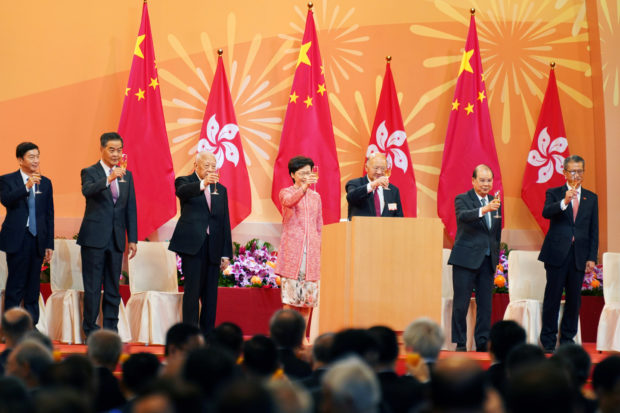
Hong Kong Chief Executive Carrie Lam raises a glass during a ceremony marking China’s National Day at Grand Hall in Hong Kong, China October 1, 2020. REUTERS/Lam Yik
HONG KONG — Hong Kong leader Carrie Lam cheered the city’s “return to stability” during China national day celebrations on Thursday, as police vans dotted the route of a banned anti-government march by pro-democracy activists.
Protesters wanted to march against Beijing’s imposition of a sweeping national security law on June 30 and demand the return of 12 Hong Kong people China arrested at sea in August on their way to self-ruled Taiwan.
Lam attended a flag raising ceremony with other senior Hong Kong and mainland officials in a centre for exhibitions surrounded by police and security barriers.
“Over the past three months, the plain truth is, and it is obvious to see, that stability has been restored to society while national security has been safeguarded, and our people can continue to enjoy their basic rights and freedoms,” Lam said.
As she spoke, groups of officers in riot gear conducted stop-and-search operations along an expected marching route linking the prime shopping district of Causeway Bay with the administrative Admiralty district.
Late on Wednesday, police said they had arrested five people for inciting participation in illegal assemblies online.
Local newspaper South China Morning Post reported earlier this week about 6,000 officers would be deployed on a day of heightened alert, citing unnamed sources.
“There are too many police on the streets,” said 27-year-old Chau on his way to getting breakfast. “It’s chilling.”
Anti-government protests, which often turned violent in 2019, have been smaller and fewer this year due to coronavirus restrictions on group gatherings and fears of arrest under the security law imposed by Beijing on June 30.
The law punishes anything China considers as subversion, separatism, terrorism and collusion with foreign forces with up to life in prison and gives police and Chinese security agents broad powers.
There have been calls online for protests in several districts after a march application by Civil Human Rights Front, which organised million-people marches last year, was dismissed by police citing COVID-19 and violence at previous marches.
It was unclear how many people would join any demonstrations.
“I don’t think protesting is an effective way to express my opinion, because the government tries every method to suppress protests,” said 22-year-old Lee as she looked at a group of police officers across the street.
‘National mourning’
Four members of the League of Social Democrats, led by veteran activist Leung Kwok-hung, known as Long Hair, marched holding a banner reading “There is no national day celebration, only national mourning.” Four is the maximum number of people allowed to gather under coronavirus restrictions.
A sore point for democracy supporters has been the capture of 12 Hong Kong people by Chinese authorities, now in detention in the mainland city of Shenzhen, having been arrested for illegal border crossing and organizing cross-border crimes.
All were suspected of committing crimes in Hong Kong related to last year’s protests.
Their arrest has compounded the fears of many in Hong Kong about what they see as China’s determination to end any push for greater democracy in the financial hub.
The Oct. 1 China national day is resented by many democracy supporters who say Beijing is eroding the wide-ranging liberties the former British colony was promised when it returned to Chinese rule in 1997.
For pro-Beijing supporters, it is an opportunity to drum up patriotism in China’s most restive city.
At the flag raising ceremony, Lam praised China’s success in curbing the coronavirus and its economic recovery, calling it “a rare bright spot” which “has shown once again the shift of the global economic focus from the West to the East.”